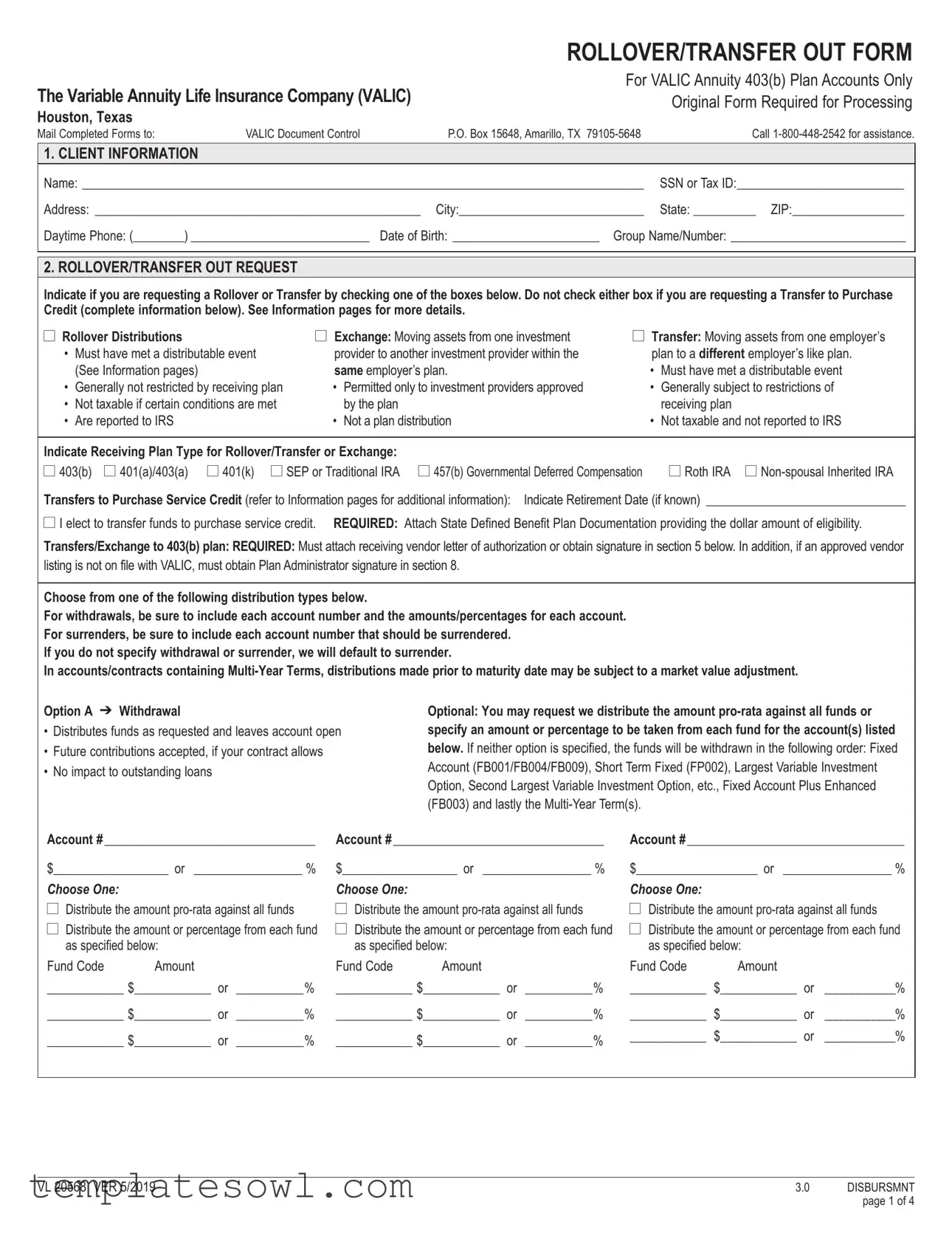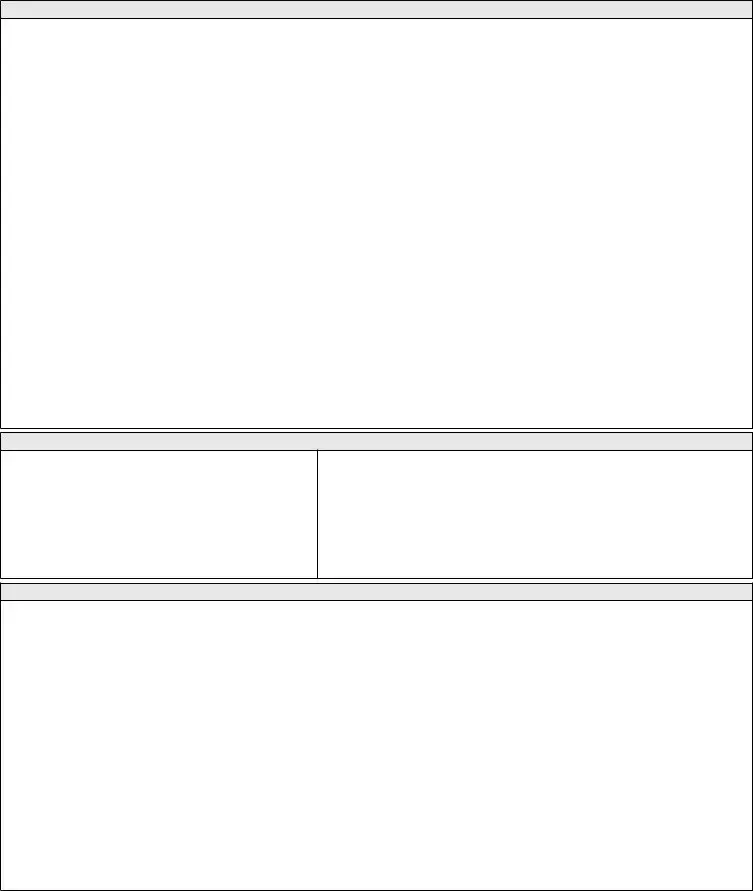Information (continued)
that penalty at the time of withdrawal unless you are over age 59½ or some other exception applies.
IN‑PLAN ROLLOVER TO A DESIGNATED ROTH ACCOUNT
You cannot roll over a taxable distribution to a designated Roth account in another employer’s plan. However, you can convert the taxable distribution into a designated Roth account in the distributing Plan.
•If you roll over the taxable account to a designated Roth account in the same Plan, the amount rolled over (reduced by any after‑tax amounts directly rolled over) will be taxed. However, the 10% federal early withdrawal penalty will not apply (unless you take the amount rolled over out of the designated Roth account within the 5‑year period that begins on January 1 of the year of the rollover).
•If you roll over taxable account to a designated Roth account in the same Plan, later payments from the designated Roth account that are qualified distributions will not be taxed (including earnings after the rollover). A qualified distribution from a designated Roth account is a payment made both after you attain age 59½ (or after your death or disability) and after you have had a designated Roth account in the Plan for a period of at least 5 years. The 5‑year period described in the preceding sentence begins on January 1 of the year your first contribution was made to the designated Roth account. However, if you made a direct rollover to a designated Roth account in the Plan from a designated Roth account in a plan of another employer, the 5‑year period begins on January 1 of the year your first contribution was made to the designated Roth account in the Plan or, if earlier, to the designated Roth account in the plan of the other employer. Payments from the designated Roth account that are not qualified distributions will be taxed to the extent allocable to earnings after the rollover, including the 10% additional income tax on early distributions (unless an exception applies).
•If the Plan permits an in‑plan Roth direct rollover option for amounts that are not otherwise distributable under the terms of the Plan, the Plan is not required to permit any other rollover or distribution options of such amounts. For more information, please contact your Plan administrator.
ROLLOVERS TO A ROTH IRA
If you roll over the payment to a Roth IRA, a special rule applies under which the amount of the payment rolled over (reduced by any after‑tax amounts) will be taxed. However, the 10% additional income tax on early distributions will not apply (unless you take the amount rolled over out of the Roth IRA within 5 years, counting from January 1 of the year of the rollover).
If you roll over the payment to a Roth IRA, later payments from the Roth IRA that are qualified distributions will not be taxed (including earnings after the rollover). A qualified distribution from a Roth IRA is a payment made after you are age 59½ (or after your death or disability, or as a qualified first‑time homebuyer distribution of up to $10,000) and after you have had a Roth IRA for at least 5 years. In applying this 5‑year rule, you count from January 1 of the year for which your first contribution was made to a Roth IRA. Payments from the Roth IRA that are not qualified distributions will be taxed to the extent of earnings after the rollover, including the 10% federal early withdrawal penalty (unless an exception applies). You do not have to take required minimum distributions from a Roth IRA during your lifetime. For more information, see IRS Publication 590‑A, Contributions to Individual Retirement Arrangements (IRAs), and IRS Publication 590‑B, Distributions from Individual Retirement Arrangements (IRAs).
LOANS
If you request a total surrender/withdrawal of your Plan account and you have an outstanding loan, the account balance will be reduced by the outstanding loan balance and if applicable outstanding loan security will be returned to the account. The loan offset amount is treated as a distribution to you at the time of the offset and will be taxed (including the 10% additional income tax on early distributions, unless an exception applies) (in the case of a nonqualified distribution from a designated Roth account, only to the extent of the earnings in the loan offset) unless you do a 60‑day rollover in the amount of the loan offset to an IRA or employer plan (or in the amount of the nonqualified distribution earnings to a Roth IRA or designated Roth account in any employer plan). You may also choose to pay off the outstanding loan balance prior to the surrender by submitting payment in full.
EXTENDED ROLLOVER DEADLINE FOR CERTAIN OFFSET LOANS
Beginning after December 31, 2017, a participant who incurs a “qualified” plan loan offset will have until the participant’s tax return due date (including extensions) for the year in which the offset occurred to make a rollover of up to 100% of the amount of the qualified plan loan offset. A “qualified” plan loan offset is a plan loan offset that occurs as the direct result of termination of employment or the employer’s termination of the plan.
VL 20568 VER 5/2019
EXTENDED ROLLOVER DEADLINE FOR CERTAIN QUALIFIED BIRTH OR ADOPTION DISTRIBUTIONS
Beginning after December 31, 2019, a participant who incurs a qualified birth or adoption distribution may rollover of up to 100% of the amount of the qualified birth or adoption distribution to the plan or an IRA without regard to the normal 60‑day rollover time limit .
EXTENDED ROLLOVER DEADLINE FOR CERTAIN CORONAVIRUS‑RELATED DISTRIBUTIONS
For coronavirus‑related distributions made on or after March 27, 2020, and before January 1, 2021, up to 100% of such distributions may be rolled over to the plan or an IRA without regard to the normal 60‑day rollover time limit for up to three years from the date of the distribution.
SPECIAL TAX TREATMENT FOR CERTAIN LUMP‑SUM DISTRIBUTIONS
If you were born on or before January 1, 1936 and receive a lump‑sum distribution (including a nonqualified distribution from a designated Roth account) that you do not roll over, special rules for calculating the amount of the tax on the payment (or the earnings in the payment for a nonqualified distribution) might apply to you (not applicable to governmental 457(b) plan distributions). For more information, see IRS Publication 575, Pension and Annuity Income.
ELIGIBLE RETIRED PUBLIC SAFETY OFFICER
If the Plan is a governmental plan, you retired as a public safety officer, and your retirement was by reason of disability or was after normal retirement age, you can exclude from your taxable income Plan payments (including nonqualified distributions from designated Roth accounts) paid directly as premiums to an accident or health plan (or a qualified
long‑term care insurance contract) that your employer maintains for you, your spouse, or your dependents, up to a maximum of $3,000 annually. For this purpose, a public safety officer is a law enforcement officer, firefighter, chaplain, or member of a rescue squad or ambulance crew.
NONRESIDENT ALIEN
If you are a nonresident alien and you do not do a direct rollover to a U.S. IRA or U.S. employer plan, instead of withholding 20%, the Plan is generally required to withhold 30% of the payment for federal income taxes. If the amount withheld exceeds the amount of tax you owe (as may happen if you do a 60‑day rollover), you may request an income tax refund by filing Form 1040NR and attaching your Form 1042‑S. See Form W‑8BEN for claiming that you are entitled to a reduced rate of withholding under an income tax treaty. For more information, see also IRS Publication 519, U.S. Tax Guide for Aliens, and IRS Publication 515, Withholding of Tax on Nonresident Aliens and Foreign Entities.
OTHER SPECIAL RULES
•If a payment is one in a series of payments for less than 10 years, your choice whether to make a direct rollover will apply to all later payments in the series (unless you make a different choice for later payments).
•If your payments for the year are less than $200 (not including payments from a designated Roth account in the Plan), the Plan is not required to allow you to do a direct rollover and is not required to withhold for federal income taxes. However, you may do a 60‑day rollover.
•Unless you elect otherwise, a mandatory cashout of more than $1,000 will be directly rolled over to an IRA chosen by the Plan administrator. A mandatory cashout is a payment from a plan to a participant made before age 62 (or normal retirement age, if later) and without consent, where the participant’s benefit does not exceed $5,000 (not including any amounts held under the plan as a result of a prior rollover made to the plan).
•You may have special rollover rights if you recently served in the U.S. Armed Forces. For more information, see IRS Publication 3, Armed Forces’ Tax Guide.
•You may have special rollover rights if you were affected by a federally declared disaster. For more information on special rollover
rights related to disaster relief, see the IRS website @ www.irs.gov
FOR MORE INFORMATION
You may wish to consult with the Plan administrator or a professional tax adviser, before taking a payment from the Plan or IRA. Also, you can find more detailed information on the federal tax treatment of payments from employer plans and IRAs in: IRS Publication 575, Pension and Annuity Income; IRS Publication 590‑A, Contributions to Individual Retirement Arrangements (IRAs); IRS Publication 590‑B, Distributions from Individual Retirement Arrangements (IRAs); and IRS Publication 571, Tax‑Sheltered Annuity Plans (403(b) Plans). These publications are available from a local IRS office, on the web at www.irs.gov or by calling 1‑800‑TAX‑FORM.




